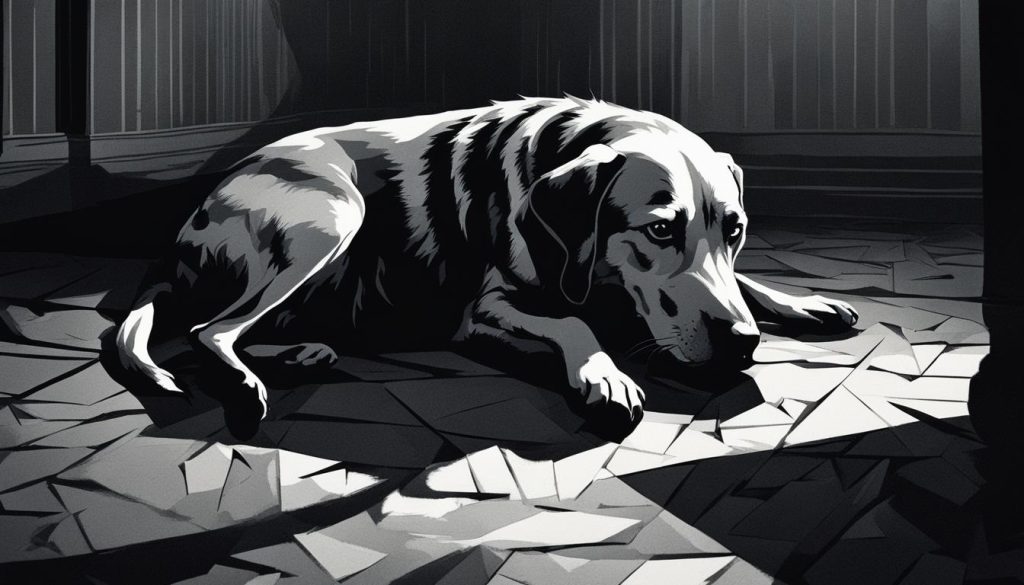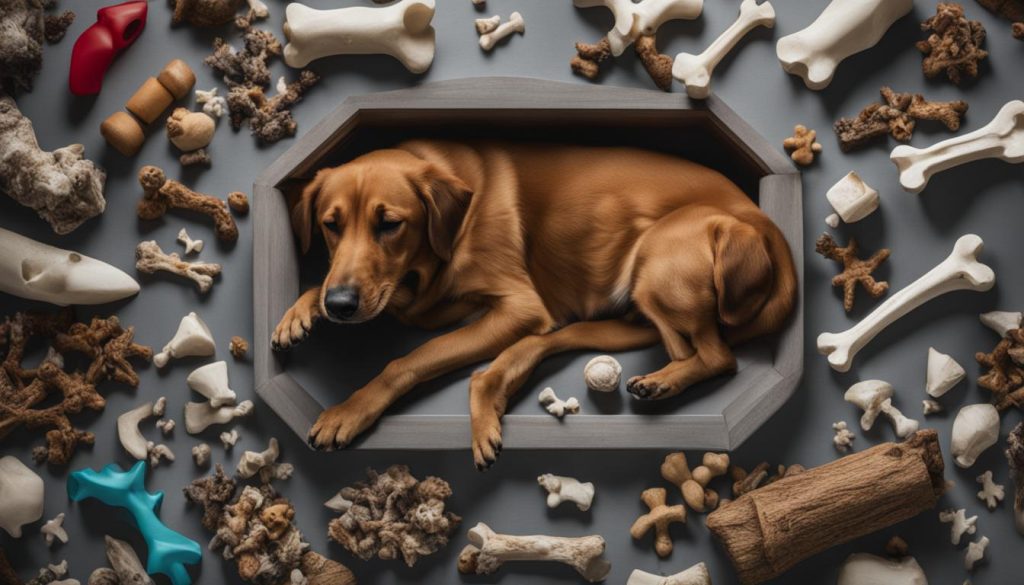When our furry companions cry or whimper in their sleep, it can be quite distressing to witness. As dog owners, we may wonder what could possibly be going on in their minds during these moments of apparent discomfort. Do dogs dream? And if so, what are their dreams about?
Understanding the dreams and sleep patterns of our canine friends can provide valuable insights into their emotions and well-being. So, let’s delve into the fascinating world of dog dreams and explore the reasons behind their crying during sleep.
Key Takeaways:
- Dogs do dream, and their dreams often reflect their daily experiences and emotions.
- Crying or whimpering during sleep may indicate that a dog is dreaming about something distressing or fear-inducing.
- Dogs can have nightmares, just like humans, which can cause them to cry out or exhibit signs of distress in their sleep.
- Several factors can contribute to dogs crying in their dreams, including recent traumatic experiences, seeking attention, pain or discomfort, anxiety, seizures, boredom, REM behavior disorder, and improper training.
- Providing a comforting environment and seeking veterinary advice if necessary can help dogs cope with nightmares and sleep disturbances.
Do Dogs Have Nightmares?

Dogs, like humans, can experience nightmares during their sleep. When a dog snarls, growls, or cries out in their sleep, it may indicate that they are having a nightmare. These nightmares can be triggered by various factors, including past traumatic experiences or fears. It is important not to wake a dog abruptly from a nightmare, as they may become disoriented and potentially react aggressively.
During nightmares, dogs may exhibit signs of distress such as increased heart rate, rapid breathing, and restless movements. They may also display behaviors like shaking or hiding after waking up from a nightmare. Dogs have the ability to remember traumatic events, and these memories can manifest in their dreams, leading to episodes of fear or distress.
To help a dog experiencing nightmares, it is essential to provide a calm and comforting environment. Soft background music can create a soothing atmosphere and help relax the dog when they wake up from a nightmare. Additionally, spending quality time with the dog, providing a secure sleeping space, and offering a favorite toy or blanket for comfort can help them feel safe and secure.
Table: Signs of Dog Nightmares
| Signs | Description |
|---|---|
| Whimpering or crying | Dogs may vocalize their distress during nightmares, whimpering or crying in their sleep. |
| Aggressive growling or snarling | Nightmares can elicit aggressive responses from dogs, causing them to growl or snarl while sleeping. |
| Restless movements | Dogs may exhibit movements such as kicking, twitching, or running legs while experiencing a nightmare. |
| Rapid breathing and increased heart rate | Nightmares can lead to physiological changes in dogs, resulting in rapid breathing and an elevated heart rate. |
Causes Of Dogs Crying In The Dream

There are several reasons why dogs may cry in their sleep. Understanding these causes can help pet owners better comprehend their dogs’ behaviors and ensure their well-being. Here are some common explanations for why dogs cry during dreams:
- Dreaming: Like humans, dogs experience dreams. During their sleep, dogs process information from their daily lives, and sometimes these dreams can evoke emotions that manifest as crying or whimpering.
- Attention seeking: Dogs may cry in their sleep as a way to get attention from their owners. They might have learned that whimpering or crying elicits a response and continue this behavior even while dreaming.
- Pain or discomfort: If a dog is experiencing pain or discomfort, it may cry or whimper in its sleep. This could be due to an underlying health issue or an injury.
- Anxiety: Dogs with anxiety may exhibit crying behavior during dreams. Anxiety can arise from various factors such as separation anxiety, fear of loud noises, or traumatic experiences.
- Seizures: Dogs that suffer from seizures may cry or make noises during their episodes, including while they are asleep. Seizures can be a serious health condition that requires veterinary attention.
- Puppy behavior: Puppies, especially during their early development stages, may cry or whimper in their sleep as a normal part of their growth and adjustment process.
- Boredom: Dogs that are bored or not sufficiently mentally stimulated may cry or whimper during sleep as a means of expressing their frustration.
- REM behavior disorder: Some dogs may experience REM behavior disorder, a condition in which their normal sleep paralysis mechanism doesn’t function properly. This can lead to physical behaviors, including crying or making vocalizations during dreams.
- Improper training: In some cases, dogs may cry during dreams due to improper training or reinforcement. If a dog has associated crying with getting attention or rewards, it may continue this behavior while asleep.
Understanding the reasons behind a dog’s crying during dreams can help pet owners provide appropriate care and address any underlying issues. If a dog’s crying during sleep becomes excessive or is accompanied by other concerning symptoms, it is recommended to consult with a veterinarian for further evaluation and guidance.
Table: Reasons for Dogs Crying During Dreams
| Cause | Description |
|---|---|
| Dreaming | Dogs process information from their daily lives while dreaming, which can elicit emotions resulting in crying or whimpering. |
| Attention seeking | Dogs may cry during dreams as a way to get attention from their owners, continuing learned behavior even while asleep. |
| Pain or discomfort | Dogs experiencing pain or discomfort may cry or whimper in their sleep, which could be due to health issues or injuries. |
| Anxiety | Dogs with anxiety may exhibit crying behavior during dreams, stemming from separation anxiety, fear, or traumatic experiences. |
| Seizures | Seizures can cause dogs to cry or make noises during sleep, indicating a serious health condition that requires veterinary attention. |
| Puppy behavior | Puppies may cry or whimper in their sleep as a normal part of their growth and adjustment process. |
| Boredom | Dogs may cry or whimper during sleep when bored or lacking mental stimulation. |
| REM behavior disorder | In dogs with REM behavior disorder, the normal sleep paralysis mechanism doesn’t function properly, resulting in physical behaviors during dreams. |
| Improper training | Crying during dreams can be a learned behavior if a dog has associated it with attention or rewards due to improper training or reinforcement. |
What to do if Your Dog Cries in Sleep

It can be concerning to witness your dog crying in their sleep. While it may indicate that they are having a nightmare or distressing dream, there are steps you can take to help comfort them and ensure their well-being. Here are some tips on what to do if your dog cries in sleep:
Create a Calming Environment
When your dog wakes up from a nightmare, it’s important to create a soothing and comforting environment. Soft music or white noise can help relax your dog and create a sense of calm. Additionally, consider providing a cozy and comfortable sleeping space for your dog to help them feel secure.
Wake Them Gently
If you decide to wake your dog up from their distressing dream, do so gently. Softly calling their name or gently stroking their fur can help wake them up without causing undue stress. Be cautious as they may be disoriented after waking up.
Offer Reassurance and Comfort
After your dog wakes up, offer them reassurance and comfort. Petting them gently and speaking to them in a soothing tone can help them relax and feel safe. It’s important to provide a calm and reassuring presence to help them recover from the nightmare.
Remember, each dog is unique, and their response to nightmares may vary. If your dog’s nightmares persist or if they exhibit signs of distress or anxiety during sleep, it is advisable to seek veterinary advice for further evaluation and guidance.
How do I help my dog get over a nightmare?

When your dog has a nightmare, it can be distressing for both you and your furry friend. However, there are several ways you can help comfort and support your dog after a nightmare:
- Provide a safe and calming environment: Create a comfortable sleeping space for your dog by ensuring they have a cozy bed or blanket. Make sure the room is quiet and free from any potential disturbances.
- Offer reassurance and physical contact: After a nightmare, your dog may be feeling scared or anxious. Comfort them by gently petting or stroking them while they sleep. This physical contact can help them feel secure and protected.
- Use soothing techniques: Playing soft music or white noise can create a calming atmosphere for your dog. You can also consider using essential oils or pheromone diffusers designed to relax dogs.
- Consult with a veterinarian: If your dog experiences frequent or severe nightmares, it’s advisable to seek advice from a veterinarian. They can rule out any underlying health issues and provide guidance on potential treatments or interventions.
By following these steps, you can help your dog recover from a nightmare and provide them with the comfort and support they need during sleep.
Do Dogs Dream About Their Owners?

When it comes to the dreams of our furry companions, one common question that arises is: do dogs dream about their owners? As a pet owner myself, I’ve often wondered about the inner workings of my dog’s sleeping mind. While we can’t know for certain what dogs dream about, it’s highly likely that they do dream about their beloved human family.
Dogs have intricate dream cycles similar to humans, and their dreams often reflect their daily experiences and memories. Since dogs form strong emotional bonds with their owners, it’s only natural that they would dream about the activities they enjoy with them, such as walks in the park, playtime, or simply relaxing together at home. Just like we might replay cherished moments in our dreams, dogs may also revisit these happy times during their slumber.
I believe that our furry friends dream of us, their owners, because we are an essential part of their lives. From the joyful moments of play to the comforting presence we provide, dogs form deep connections with us, and these connections undoubtedly find their way into their dreams.
While we can’t ask our dogs directly about their dreams, their behaviors during sleep can provide some clues. If you’ve ever observed your dog’s tail wagging or heard them make contented noises while sleeping, it’s a good indication that they’re experiencing pleasant dreams. These signs give us a glimpse into their subconscious world and suggest that our presence in their dreams plays a significant role.
Table: Activities Dogs Dream About
| Activities | Examples |
|---|---|
| Playing with toys | Chasing a ball, tugging on a rope |
| Interaction with owners | Going for walks, cuddling |
| Eating favorite meals or treats | Enjoying a tasty bone or a delicious snack |
| Engaging in familiar experiences | Exploring the backyard, visiting the dog park |
While we may never truly know the exact content of a dog’s dreams, the strong bond between dogs and their owners suggests that we are frequently part of their slumbering adventures. So the next time you see your furry friend curled up in dreamland, remember that they may just be chasing a ball or enjoying a leisurely stroll with you by their side.
What Kind of Things Do Dogs Dream About?
Dogs, like humans, have a rich and vivid dream life. While we can’t know for sure what they dream about, their dreams likely revolve around activities and experiences that bring them joy and excitement. Just like you may dream about winning the lottery or going on a dream vacation, dogs may dream about playing with their favorite toys, enjoying their favorite meals or treats, and engaging in familiar experiences.
Dogs may also dream about activities they enjoy with their owners, such as going for walks, playing fetch, or cuddling on the couch. These dreams allow them to relive and process the positive emotions associated with these experiences. It’s heartwarming to imagine our furry friends running, jumping, and wagging their tails in their dreams as they chase after imaginary squirrels or receive endless belly rubs.
While we may never fully understand the content of a dog’s dream, we can observe their behavior during sleep to get a glimpse of what they might be dreaming about. If you notice your dog twitching, wagging their tail, making noises like whimpering or barking, or even running in their sleep, it’s a good indication that they are experiencing vivid dreams. These dream behaviors serve as a window into their imagined world.
“Dogs have given us their absolute all. We are the center of their universe. We are the focus of their love and faith and trust. They serve us in return for scraps. It is without a doubt the best deal man has ever made.” – Roger Caras
As much as we may wish to know exactly what goes on inside our furry friends’ minds during their dreams, the truth is that the specifics will forever remain a mystery. What is clear, however, is that dogs dream, just like humans do, and their dreams likely bring them a sense of happiness and fulfillment. So the next time you see your beloved canine companion twitching and wagging their tail in their sleep, remember that they are off on their own little adventure, chasing their dreams in a world only they can see.
Is my dog dreaming or having a nightmare?
It can be challenging to determine whether a dog is dreaming or having a nightmare. Dogs exhibit various signs during sleep that can help distinguish between dreams and nightmares. When a dog is dreaming, you may notice movement of the eyes behind closed eyelids, tail wagging, and random muscle movements like twitching. They may also make noises like whimpering, growling, or barking. These signs indicate that your dog is likely experiencing dreams during sleep.
On the other hand, nightmares in dogs can be identified by more intense and distressing behaviors. They may cry, howl, or scream during sleep, accompanied by aggressive growling. It’s crucial not to forcefully wake the dog during these episodes, as it may cause disorientation and potential harm. Instead, create a calm and comforting environment to help them relax naturally.
Observation and familiarization with your dog’s sleep patterns and behaviors are key to understanding whether they are dreaming or having a nightmare. Paying attention to their body language, sounds, and movements can provide valuable insights into their emotional state during sleep.
Signs that Dogs Give When They Dream

In order to understand if your dog is dreaming, there are several signs you can look out for. Dogs have unique behaviors and reactions while dreaming, which can give you an indication of their dream state. These signs include:
- Movement of the eyes behind closed eyelids: Dogs’ eyes may twitch or move rapidly while they are dreaming, similar to humans during REM sleep.
- Tail wagging: Some dogs may wag their tails while dreaming, indicating that they are experiencing something positive in their dream.
“Dogs may bark, growl, or whimper while they are dreaming. These vocalizations can vary from soft whimpers to loud barks, depending on the content of their dream.”
- Making noises like whimpering, growling, or barking: Dogs may vocalize during their dreams. These sounds can range from soft whimpers to loud barks, reflecting the content of their dream.
- Random muscle movements like twitching: Dogs may experience muscle twitches or jerks while dreaming, similar to humans experiencing muscle twitches during dreams.
- Running movements with their legs: Some dogs may move their legs as if they are running while they are dreaming, suggesting that they are engaged in an active dream scenario.
These signs collectively indicate that dogs are likely experiencing dreams during sleep. Just like humans, dogs also have an active dream state where they process information and potentially relive past experiences.
| Dream Signs | Meaning |
|---|---|
| Movement of the eyes behind closed eyelids | Indicates REM sleep and active dreaming |
| Tail wagging | Suggests positive experiences or content in the dream |
| Making noises like whimpering, growling, or barking | Reflects the content of the dream and potential interactions within the dream scenario |
| Random muscle movements like twitching | Similar to human muscle twitches during dreams, likely related to dream scenarios |
| Running movements with their legs | Imitates an active dream scenario, potentially involving physical movement or chase |
Observing these signs can give you a glimpse into your dog’s dream world and provide insight into their emotional experiences during sleep. It is important to remember that dreams vary from dog to dog, and each individual may have unique dream behaviors. Paying attention to these signs can enhance your understanding of your furry friend’s inner world.
Wrapping Up
To summarize, dogs are not only capable of dreaming, but their dreams play an essential role in their emotional and cognitive well-being. Just like humans, dogs process information and memories during sleep, which often translates into vivid dreams. These dreams encompass enjoyable experiences, such as playing with toys, going for walks, or spending time with their favorite humans. It is a testament to the deep bond dogs form with their owners that they may also dream about them.
However, it is crucial to remember that dogs can also experience nightmares. When a dog cries out, snarls, or exhibits signs of distress during sleep, it may indicate a nightmare. It is essential not to wake them forcefully, as this can lead to disorientation and potential aggression. Instead, providing a comforting environment and seeking veterinary advice if necessary can help dogs cope with their nightmares.
Understanding and respecting a dog’s sleep patterns and dream experiences is a crucial aspect of responsible pet ownership. By recognizing the signs of dreaming and nightmares, we can provide the support and care our furry companions need to have restful and peaceful nights. So, the next time you see your dog twitching, wagging their tail, or making noises in their sleep, you can rest assured knowing that they are venturing into a world of dreams, just like we do.
FAQ
What do dogs dream about when they cry?
Dogs may cry or whimper in their sleep if they are dreaming about something that causes distress or fear. This could be related to a recent traumatic, painful, or scary experience. Dogs have emotions and their dreams often reflect their daily lives. They may also cry, howl, or growl during sleep.
Do dogs have nightmares?
Yes, dogs can have nightmares just like humans. When a dog snarls, growls, or cries out in their sleep, it may indicate that they are having a nightmare. It is important not to wake them up immediately, as they may become disoriented and potentially lash out. Dogs remember traumatic events during nightmares.
What causes dogs to cry in their sleep?
Several factors can cause dogs to cry in their sleep. These include dreaming, seeking attention, pain or discomfort, anxiety, seizures, puppy behavior, boredom, REM behavior disorder, and improper training. Dreaming is a common cause, where dogs process information from the day in their sleep. Seeking attention, pain, anxiety, seizures, and boredom can also trigger crying during dreams.
What should I do if my dog is crying in their sleep?
If your dog is crying in their sleep, it may be distressing to witness. You can gently wake them up by softly calling their name, being cautious as they may be disoriented. Watching them until they wake naturally is also an option. Offering soft music to create a calming environment can help relax your dog when they wake up from a nightmare.
How do I help my dog get over a nightmare?
Spending quality time with your dog, providing a comfortable sleeping space, playing soothing music before bed, and giving them cuddle toys to create a sense of security can help your dog overcome nightmares. Additionally, petting them while they sleep and seeking veterinary advice for severe health conditions or persistent pain is recommended.
Do dogs dream about their owners?
Dogs are likely to dream about their owners because they often dream about recent experiences and memories. Dogs enjoy activities involving their favorite humans, so they may dream about walks, playtime, or spending time together.
What kind of things do dogs dream about?
While we can’t know for sure, dogs likely dream about activities they enjoy, such as playing with toys, eating their favorite meals or treats, and engaging in familiar experiences. Dogs may also dream about exciting moments like going for walks or car rides.
Is my dog dreaming or having a nightmare?
It can be challenging to determine whether a dog is dreaming or having a nightmare. Signs that a dog is dreaming include movement of the eyes behind closed eyelids, tail wagging, making noises, growling, random muscle movements, and running legs in their sleep. Nightmares may cause cries, aggressive growls, or screams, but it’s crucial not to forcefully wake the dog during these episodes.
What signs do dogs give when they dream?
Dogs give various signs when they are dreaming. These signs include movement of the eyes behind closed eyelids, tail wagging, making noises like whimpering, growling, or barking, random muscle movements like twitching, and running movements with their legs. These signs indicate that dogs are likely experiencing dreams during sleep.
Can you provide a conclusion on dog dreams?
Dogs do dream, similar to humans. They have sleep phases that include dreaming, and their dreams likely revolve around enjoyable experiences and memories. Dogs may also have nightmares, but it’s important not to wake them forcefully. Providing a comforting environment and seeking veterinary advice if necessary can help dogs cope with nightmares.






